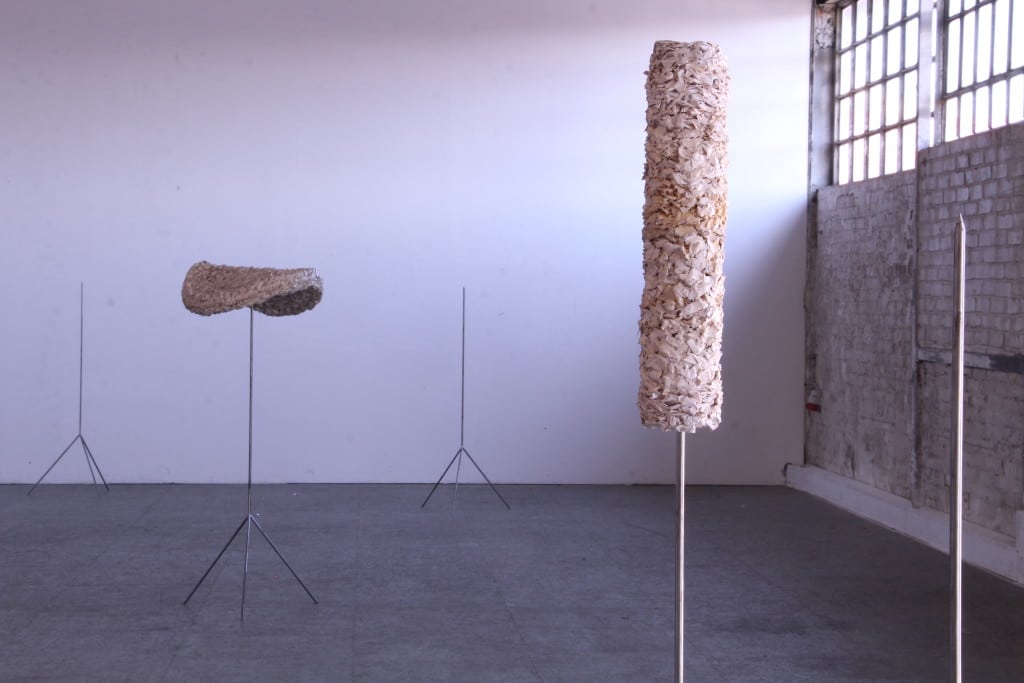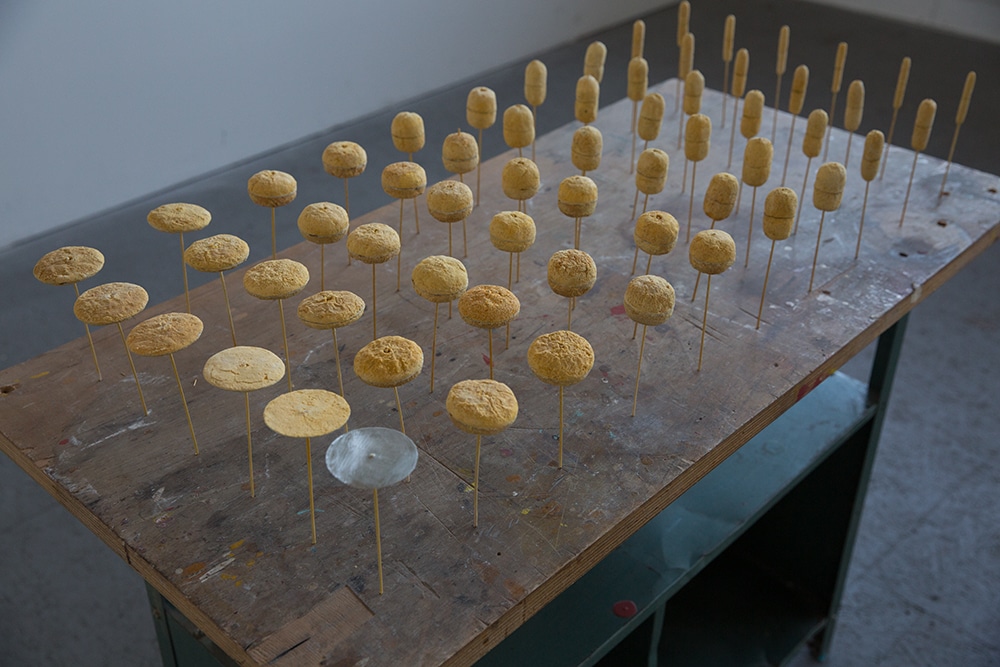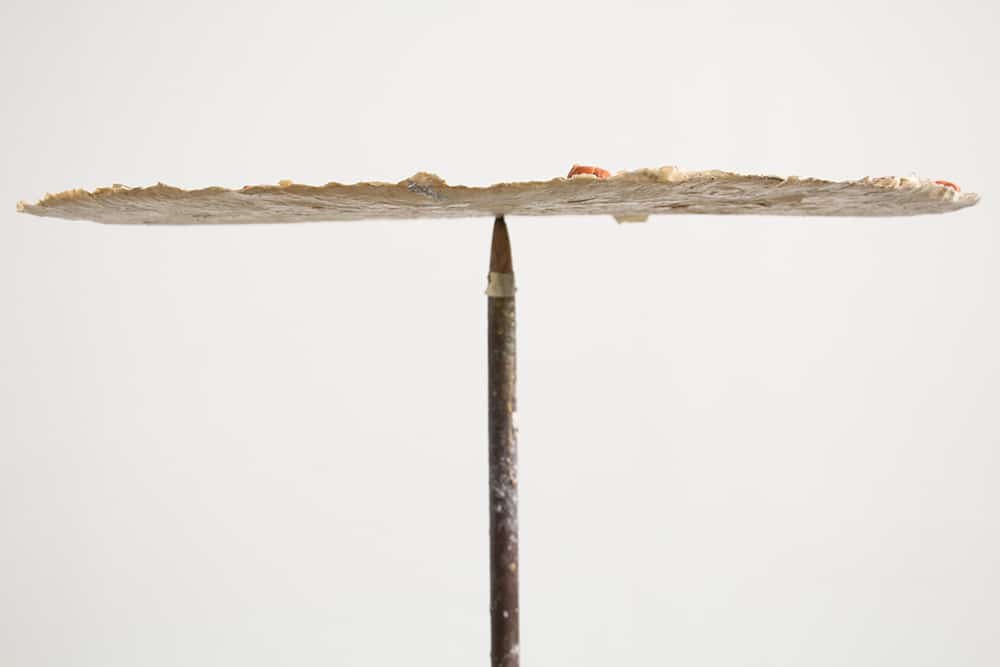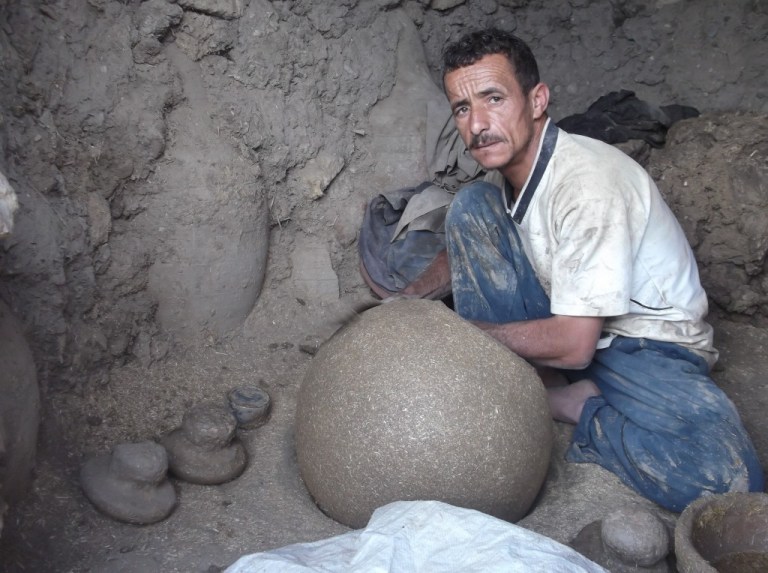In the first months of this year an artistic investigation took shape in my mind that I became determined to pursue: to make a sequence of papier-mâché sculptures whose simple forms will be determined by my bodily geometry. I think the series will be called The Embraces. I want to see what happens when geometric shapes become tangible things. I will make a sequence of forms, each further from flatness than the last: a stiff circle will be joined by spheres and zeppelins, and a square by cubes and pillars.
I realised the process will take months of work in a hot dry environment. I need to build up the sculptures in parallel, adding paper to each one each day, then letting it dry overnight. After much research I found the Fayoum Art Center, which has hosted international artists in residence since it opened in 2006. It is in Tunis Village, 150km south west of Cairo, where the northern Sahara meets the huge and tranquil Lake Qarun. Originally opened by the Egyptian painter Mohamed Abla, it is now run by his daughter Noura, a curator, and son Ibrahim, a filmmaker. They have invited me to stay for seven months, (or until the Saharan summer becomes too much for me!). I will arrive on the fourth of November. I’ll then return in the autumn of 2019 to prepare for an exhibition of the work in Cairo.
I am certain this is the right place to do this work. The climate is ideal and I will have a huge, peaceful studio and courtyard studio to work in. The Centre is closely integrated into the life of the village, which has workshops and pottery studios, so I’ll have access to simple wood and metal facilities.
Apart from these practical advantages, the cultural, archaeological and natural context of Tunis is extremely relevant to my way of thinking and making.
In the nearby village of Al Nazla, there are many potteries, where vessels are made from a mixture of mud, ash and straw. This is pressed into shape against the sides of curved holes in the ground, which the potter crouches over, using his hands, arms and shoulders as much as his tools. The close physicality of the process seems oddly parallel to my own. But while I’ll be improvising uncertainly, these potters possess incredibly ancient bodily knowledge: pots have been made just like this since the time of the Pharoahs.
In ancient Egyptian, Greek and Coptic sites nearby, I’ll see examples of ‘circle’, ‘pyramid’ and ‘cube’, made when these apparently eternal concepts were still new tools of human language, image and architecture. Amazingly, I’ll be able to put my own forms on nearby ground and see how they relate: to each other, these ancient counterparts, and the ageless air. I’ll spread them into the distance, too, until they loose materiality and become symbol-like again. Having access to that massive space will be an incredible challenge and privilege. I’ll make drawings and photographs to examine how my faculties of perception are interpreting this situation, as well as to record it. Those images will also help me see my work in the context of other artists. I’ve made site specific work before but nothing approaching ‘Land Art’, with its particular reliance on documentation, so there is a lot to be learnt and tested.
But it is important that the sculptures’ first audience will be the people of Tunis. The population is made up of newcomers drawn by the contemporary pottery scene, and ancestral villagers, many of whom will never leave Tunis, and whose experience of life and creative work is so different from my own. This is their desert. I hope they find the things I put there exciting and memorable. My understanding of what encountering art can be, what it can mean, will certainly be stirred up and deepened by these months in Tunis village.
To make the sequence of forms, I will start with a series of flat shapes, between 10 and 70 centimetres in diameter. They are made of unprinted, off white newsprint paper, torn into thousands of pieces between finger and thumb, and stuck together in tight layers with PVA glue.
At the middle of each disc there is a small thin steel plate with a nipple-shaped hollow hammered into the centre. When this is placed on the sharp point of a vertical metal rod, so the point sits inside this concave depression, the disc can balance like a percussionist’s cymbal. I’m interested in objects with a perceptible relationship with the particles around them: that muffle, resonate, or refract. A cymbal is an object of suspense that speaks of energy and noise even when it is still and quiet.
When I arrive in the courtyard studio of Fayoum Art Center, I will place each disc onto its point-tipped metal stand, which are made high enough so that the cymbal is level with my shoulders: at hug-height. By the time I’m done they will also each be, in their own way, hug sized.
If you stand very close to a tiny 10cm cymbal, so it touches your chest, connect your fingertips at its furthermost edge, put one elbow straight up, and the other straight down, a thin vertical space is made by the arms, like a zeppelin. At the other extreme, straining your arms straight out in front of you to reach around the largest, 70cm wide cymbal, there’s no room between the arms for anything but disc.
Each cymbal will have its own space-shape, according to an equation between volume and surface area that will only be found through months of embraces. Gradually, it will be sandwiched between thousands of thumb-torn bits of paper, this time crumpled into gluey 3D scrumples. I’ll add and add, unbalancing and rebalancing, until my fingertips can just touch around it, and the space inside my arms is full.
I’m excited to see the characters of these things of accumulated action. In recent years I’ve noticed the tension that appears where newly fixed solidity meets untouched space. It is caused, I think, by a collision of time-spans. Hours of scrumpling, threading or pulping are thought strangely-spent and long. The objects seem fragile and temporary. The air is unthinkably old yet effortlessly energetic. Over months, the Saharan air’s bright heat will turn the paper a strange bleached yellow so it becomes a desert material.
I hope so. The working method feels simple and clear, but I’ve learnt that it is only when the nature of materials and forces surprise me and I find myself steered into the unknown that the work gains its own compelling identity.
How the completed objects are understood on close examination will depend on what all the energetic processes of their making seem to speak of: The coagulating, bleaching action of sun and wind; the instinctual architecture of birds and insects; the peculiarly expressed logic of one person, a ‘contemporary artist’… Context will influence this balancing act of resemblances. The works will be exhibited in Cairo, and maybe Berlin or London. To see them away from the dusty sand dunes around the Art Center will be to learn their identities anew.
There’s been a lot to organise: funding, materials, shipping, what to do about my studio, my flat, trying to find an audience for the work, in Egypt and in Europe… I’ve had to accept that most of my work-time has been work outside of the studio for a good few months. I know that lots of artists work in distinct phases of planning then making, but this has been new to me. When it’s unsettling I remind myself that I feel sure that the sculptures are worth making and that this preparation is a necessary part of the creative process. The most significant job has been trying to find funding. I’ve applied for various grants and made enquiries to foundations and museums, with limited success. I’m waiting to see if I’m granted a stipend from the Berlin Senate for Culture that would cover my costs. If not, I’ll be trying to find funding as I go. The Swedish Embassy and the British Council are both interested in the project and we’re discussing funding for the exhibition in Cairo next year. Luckily, costs of important things, like food and PVA glue, are very low by European standards.
I also had to source a huge amount of newsprint paper. While making a large papier-mâché installation in 2016, I discovered that newspaper printing factories throw away every newsprint roll with 1cm’s depth of paper left on it, when it becomes too light to hold the tension through the printing press. I used these ‘waste bobbins’. Brilliantly, after a lot of internet research, I made contact with Youssef Shaheen, the co-owner of Youssef Allam Group, a company that turns this waste newsprint into cardboard. Brilliantly, the company are willing to sponsor the project by donating the paper I need. I am looking forward to seeing their factory, which sounds fascinating. Thank you Youssef Allam!



